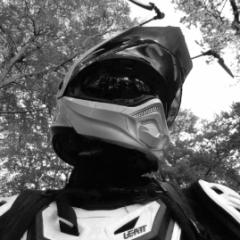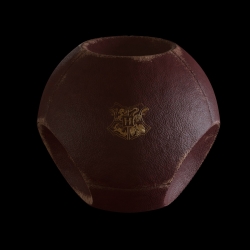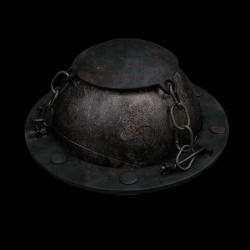
Cerbera
Community Staff-
Posts
17,815 -
Joined
-
Days Won
698
Content Type
Profiles
Blogs
Forums
Gallery
Pipeline Tools
3D Wiki
Plugin List
Store
Downloads
Videos
Everything posted by Cerbera
-
R21 would make an amazing job of this, given that it can scale a spline within the Volume Builder, and can put ends on sweeps like that but you can get very close procedurally with R20, and to perfection with a little manual modelling help... You can do it with a simple sweep, 8 sided n-side primitive swept along a uniform bezier path spline under SDS and using the scaling in the sweep to give you the perfect bulges where you need them. The only bit you'll struggle with is the caps, but my vote would go to not using the caps in the sweep, and stitching on a half hexasphere to each end... CBR
-
Well what a nice thing to come on here and say that ! Thank you dude - much appreciated by all of us I am sure ! :) Keep on working and learning and I'm sure we'll be seeing your own work there too before long... CBR
-

Cinema 4D Can only render out in 30 fps
Cerbera replied to Iwanttolearn's topic in Animation - Do Not Post Here
Please take care to post in the right place, which is not INTRODUCTIONS. Moved to ANIMATION / EXPORT. It wouldn't make any sense to limit the educational version, frame rate-wise, so fairly sure that has nothing to do with it. I agree AFX might be the issue here as it sounds like you are doing everything right in Cinema... CBR -

(R17) Dynamic Array along spline?
Cerbera replied to jericsynrgy's topic in Modelling - Do Not Post Here
No worries - I sorted that out for you... you can select all the text, cut and paste it, then the 'paste as unformatted text' will appear ! CBR -

Cinema 4D Restoring Overwritten file
Cerbera replied to Spencer Fanuka's topic in Miscellaneous - Do Not Post Here
@Spencer Fanuka Why have you posted all your posts today in the Introductions section ? CBR -

Cinema 4D Replace Materials on Many Objects
Cerbera replied to BigAl3D's topic in Modelling - Do Not Post Here
Yes, or rather sort of. To temp replace all the mats, in the Renderer Options, you can check Material override... Think it's all or nothing though - not just 1 mat... CBR -

RIGGING CHINESE DRAGON
Cerbera replied to Sobirjon Ismatullaev's topic in Tips | Tricks | Mini Tutorials
Please forgive the following, which is not intended as a personal attack, but more of a general caution... I haven't looked at the rigging one yet, but as a modelling tutor myself I did the see the first part to this, and was worried by some of the techniques and mistakes going on in it. Ngons and triangles were both allowed with no explanation for why that might be bad modelling practice, and your order of operation was wrong throughout it, given that you had SDS under Symmetry for most of it, which is technically incorrect and might lead to various problems with people trying to follow it. Whilst I would ordinarily encourage modelling tutorials of all levels, I find it hard to condone or promote the ones that give wrong or incomplete information. I say this to be helpful rather than critical, but what we don't need is modelling tutorials showing people the wrong way to do stuff - there are more than enough of those as it is ! :/ But again, thank you for putting in the effort to make these, which I know is not insignificant, and for sharing, but perhaps lay off the modelling tuts until you are expert enough in that field to be able to correctly teach it in videos such as these... CBR -
Yes it is, isn't it ? :) I'm afraid I haven't got time to explain the basics of the cloner when the manual and 500 tutorials online have already done it. I thought your question here suggested you hadn't seen any of those, and knowing that everyone here will assume you have at least some knowledge of how to use the tool, I advised you where to look in the first instance if you didn't. That remains excellent advice if that is the case ! He is showing you those models so that you can see the topology of them, and by extension, get some insight into how they were created, rather than so that you can buy one ! As professional as what ? Your reference pics are all 2D digital illustrations, so you haven't shown us any representation of what you are trying to achieve in a 3D game engine context. I imagine that's why @digitvisions showed you the TS models so we could try and get a handle on what sort of model you are expecting, or might qualify in your mind as 'professional'. We're also dealing with the fact that 'beautiful, professional results', and 'model for a game engine' are often diametrically opposing criteria, so some information about where on the line between them you are aiming for would be helpful. There are absolutely loads of approaches to making this - some are suitable for beginners, such as the cloner method I suggested, whereas others would require you to have several years of modelling or other general Cinema experience, but you don't mention what your level of experience is, how well you know the toolset etc. You could also use 2D sprites within a 3D game engine, so we can't even be sure you need a 3D model at all !! So it's actually quite difficult to know what to recommend to you given the lack of precise detail. It was a very general, wide question, so it's gonna get pretty general answers until we can narrow down what it is you actually want... CBR
-

Cinema 4D Noob question about cloner and effectors
Cerbera replied to Strontium's topic in Animation - Do Not Post Here
There's an Edit Profile Button, top right of your profile. Version options are in there... cheers CBR -
-
Look in your manual for the cloner object, or watch some Youtube tutorials on it. Although now you have mentioned a game engine that may not be a valid way to go any more... CBR
-

Cinema 4D Noob question about cloner and effectors
Cerbera replied to Strontium's topic in Animation - Do Not Post Here
Let's have that updated in your profile too please... CBR -
Ok I moved it for you, but this may have more to do with modelling than you'd think... Or we could try with textures, or maybe even with Pyrocluster ! But Sketch'n'toon / cel shading is probably going to be used somewhere if you want your images to look like that reference. 1. Modelling. I'd start by cloning a load of spheres (random effector for scale) onto a sheep-shaped body mesh and see if that gave you a suitable sort of mesh silhouette... Or you could work in 2D, then use spline mask to combine a load of circle splines into that sort of shape. 2. Then I'd setup my toon style materials, and start seeing what the render looked like, and go from there... If you are not familiar with Sketch n Toon, which can be quite complex, there are a number of videos on Youtube that will explain the basics... here's one... CBR
-

Cinema 4D Noob question about cloner and effectors
Cerbera replied to Strontium's topic in Animation - Do Not Post Here
Not that he can see that if he has got R16 as his profile says... CBR -

Close Polygon Hole - Cut Hole in Poly?
Cerbera replied to Aporia's topic in Modelling - Do Not Post Here
You're welcome... It takes a little while (several years) to learn Subdivision Surface / Poly modelling, so you won't find a single video that could possibly cover it all... But the cafe is a very good place to start ! Our own Jedi Master @Hrvoje has done a particularly good series... Start modelling small, simple objects once you have a basic understanding of the tools, and you'll be well on your way. We are here to help with any specific challenges you face... CBR -
You're missing out on a lot of love doing that, IMO ;) CBR
-
-
From the album: Current Stuff
Part of an ongoing set I am making. All SDS, Physical Render...© luminetrics
-
-

Close Polygon Hole - Cut Hole in Poly?
Cerbera replied to Aporia's topic in Modelling - Do Not Post Here
I can save you a lot of work actually if I just give you my file, which you can easily make the right length by just grabbing the selected points and moving them on Z, which will do the other side as well because of the symmetry setup... Polysplines.c4d Hope that helps CBR -

Close Polygon Hole - Cut Hole in Poly?
Cerbera replied to Aporia's topic in Modelling - Do Not Post Here
It is going to be very difficult to make this with splines because the amount of points on the inside is way different to the amount of points on the outside, so any automated process generating a surface between them has a high likelihood of error. Close polygon hole is a Polygon tool, and because these meshes were generated by splines, even though they are poly objects now they are not following the polygon modelling rules that would allow these sorts of poly tools to work correctly. That sort of rules out using splines for this in my opinion, and you are left with the option of making it out of polys from the ground up, which will work with all the poly tools, but does require a higher level of modelling skill overall and a little more time. You can use symmetry to halve the amount of work you need to do, but essentially, you need to make a poly version of that first endcap, from which we can subsequently make everything else. Using your profile spline merely as a visual guide, I'll show you roughly what that should look like when it's made out of proper hand-made polygons... Once you have the cap as polys it becomes relatively trivial to extrude out a length of that then cut it at 45 degrees, at which point you can create the end cap on the angled part relatively quickly, because all the points will still match. CBR -

Cinema 4D Should I use Mospline for this?
Cerbera replied to M G's topic in Animation - Do Not Post Here
That could work if you used exclusively luminant or hair materials so that the joins weren't made visible by external lighting etc. 1. You can split a spline, and maintain the curvature... I did this via the Split Command, but when you delete the split points from the original spline you just need to take the point where they join out of the selection you will delete or you will lose the end segment. 2. You can render these splines in a few different ways. Here I used 2 Hair materials but had to make quite alot of adjustments to them (particularly under illumination tab) to get them to be truly luminant and consistent along their lengths. The difficulty remains in how to animate these, it seems (to me at least) unlikely that you can do so without recourse to manual point level animation and a rather complex multi-spline setup... Furthermore, making 2 splines seamlessly or procedurally animate after 'joining' is a whole nest of vipers I can't see how you can easily avoid... CBR -

Cinema 4D Should I use Mospline for this?
Cerbera replied to M G's topic in Animation - Do Not Post Here
TBH, when I first saw your reference my initial thoughts were - that's 2D - why are we trying to do this in a 3D program at all ?! I'm not saying we can't, but it might be a damn sight harder than putting it together in a 2D animation app ! The only use for moSpline I can see being helpful in making that animation would be to enable you to grow custom splines, something which may not be necessary anyway, because you can use sweeps and other 3D methods to grow actual renderable geometry on that would serve just as well or better. I can't see how any other property of MoSpline could help produce that animation, but perhaps others can... The main reason that I think Cinema is generally unsuitable for this is that the reference includes so many splines that begin separately, but then join seamlessly to other ones, which is fundamentally opposed to the way that splines work in Cinema. You could possibly circumvent that issue in R20 with the Volume Builder, but of course you don't have that in R19. In that version, splines can be joined via metaballs, but it's not very efficient, and you'd have almost zero control of topology. CBR -

Close Polygon Hole - Cut Hole in Poly?
Cerbera replied to Aporia's topic in Modelling - Do Not Post Here
Post moved to correct section (modelling / splines etc). It sounds like the Close Polygon Hole Command has simply failed on that geometry, which, TBH, it is likely to do when closing that sort of hole. The reason it can't work properly could be caused by one or several of many factors, all of which are quite complex to explain, but as it doesn't work, you need to manually help it along by placing some polys yourself in key places and before the shape is made editable, by making sure that your spline interpolation gives the form enough edges to work with... As @Igor says if you upload the scene file, we'll be able to help a lot more and tell you which polys you need to bridge... We should also ask if there is any reason you are not making the whole square profile at once, rather than in 4 separate pieces. Do they have to come apart in an animation for example ? Even then, it might be better to sweep along a rectangular path, and cut the geo up into sections after it has been made editable... CBR -
I posted a link to some VR 3D sculpting software (came with Occulus I think) a while back. That seemed pretty damn impressive, so it's on my radar as being something worth investigating, but I don't have any hardware yet so haven't tested it in person... CBR



